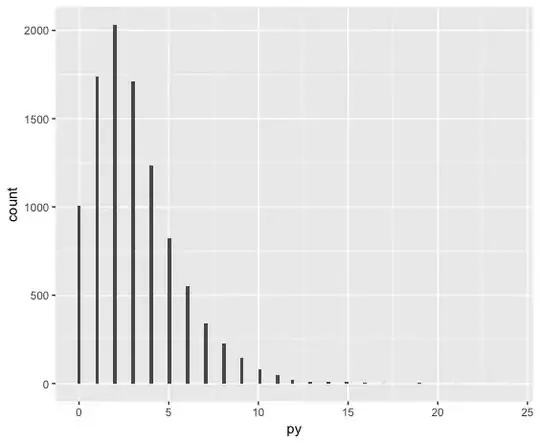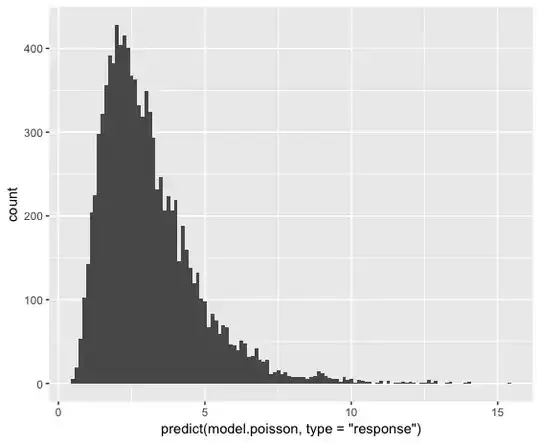I am reading "Modelling Count Data" by Hilbe and I feel I am missing something fundamental about Poisson Regression.
$\hat{\mu} = \exp(\alpha + \sum\beta_ix_i)$
One of the requirements for using it is that the underlying distribution generating my data is capable of producing counts of zero.
What I don't understand: how can such a model predict a count of zero? If it can't, how is this a useful model of my data?
Example (in R)
library("ggplot2")
library("COUNT")
# Simulation weights
b0 = 1
b1 = 0.5
b2 = 0.01
# Simulation variables and observations
obs.num = 10000
x1 = rnorm(obs.num)
x2 = rnorm(obs.num)
py = rpois(obs.num, exp(b0 + b1*x1 + b2*x2))
# Poisson Regression
model.poisson = glm(py ~ x1 + x2, family=poisson)
# Inspect Results
summary(model.poisson)
ggplot() + aes(py) + geom_histogram(bins=120)
ggplot() + aes(predict(model.poisson, type="response")) + geom_histogram(bins=120)
The summary looks good in-so-far as it gets the estimates:
Call:
glm(formula = py ~ x1 + x2, family = poisson)
Deviance Residuals:
Min 1Q Median 3Q Max
-3.3435 -0.8094 -0.1061 0.5842 3.8852
Coefficients:
Estimate Std. Error z value Pr(>|z|)
(Intercept) 1.002306 0.006376 157.205 <2e-16 ***
x1 0.501053 0.005659 88.535 <2e-16 ***
x2 0.012516 0.005675 2.205 0.0274 *
---
Signif. codes: 0 ‘***’ 0.001 ‘**’ 0.01 ‘*’ 0.05 ‘.’ 0.1 ‘ ’ 1
(Dispersion parameter for poisson family taken to be 1)
Null deviance: 18964 on 9999 degrees of freedom
Residual deviance: 11070 on 9997 degrees of freedom
AIC: 37494
Number of Fisher Scoring iterations: 5
But the plot of the predictions shows that no 0 predictions were made:

